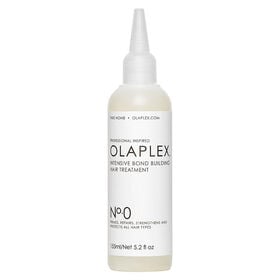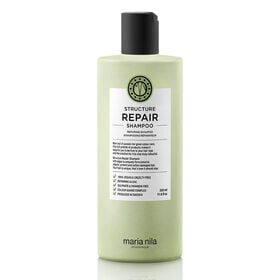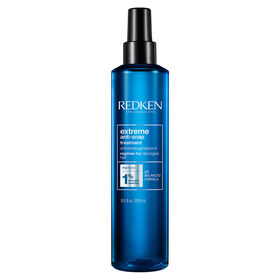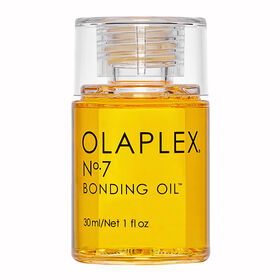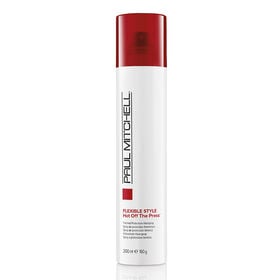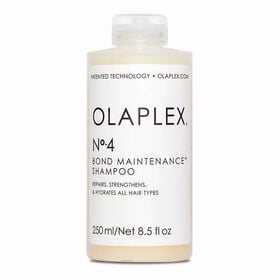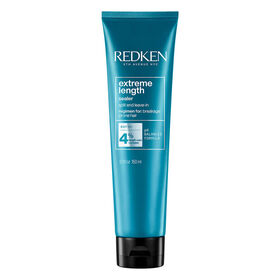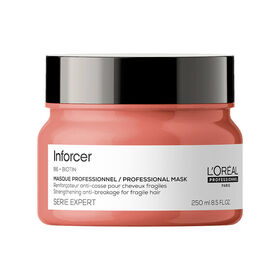How to add strength to damaged hair
Straw-like dryness. Clumps of hair stuck in your brush. An increase in split ends. These are the tell-tale signs of dry , damaged hair and it’s time to add a dose of strength into your care routine. Read our guide below for more information including the causes for your damage, how to treat your specific hair type and all the care products to leave your hair strong and healthy.
How do I look after my damaged hair?
What causes hair damage?
Hair damage is often caused by environmental and lifestyle factors aggressively attacking the outer layer of your hair. Resulting in split ends, brittleness and a dull finish, such aggressors can include overusing colour and chemical treatments, excessive heat styling and vitamin deficiencies.
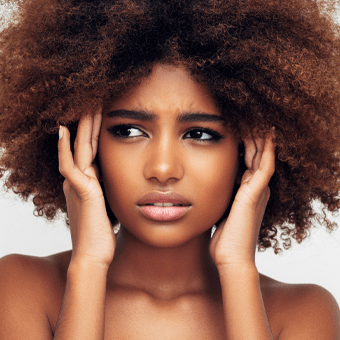
Looking after your hair type

Fine Hair
Fine hair is very fragile and prone to breakage, often leaving your strands split and straw-like. So when it comes to your hair care, less is definitely more. It’s important to keep a consistent hair care routine filled with keratin and moisturisers, including leave-in conditioners and clarifying shampoos, and also avoid excessive heat styling. If you can’t stay away from the heat, always make sure you apply a heat protection spray first and keep the temperature low on your styler.

Medium Hair
Medium hair is less prone to breakage than fine and coarse textures, meaning you have more options when choosing care and styling products. However, that doesn’t mean it’s immune from damage. The most common cause is from heat styling products. With this in mind, we recommend a routine consisting of weekly/bi-weekly shampoo and conditioning to cleanse and rebalance your hair. To avoid weighing your hair down with too much moisture, fight your damage with lightweight oils and sprays.

Coarse Hair
The good part about coarse hair is it’s strong enough to tolerate high temperatures and hold tight hairstyles. However, it can be vulnerable to damage when heat styled as the oils that keep your hair healthy actually stay in your roots. To handle your damaged hair, you’ll need to add a boost of moisture into your routine. This generally includes incorporating sprays, masks and oils infused with coconut oil, Aloe Vera and shea butter. To keep your hair thick and healthy, keep heat styling to a minimum and try to hold your hairdryer six inches away when drying your hair.
Treating your hair texture
Straight
The most important way to keep your straight hair healthy and strong is by sticking to a regular shampoo schedule. For this reason, we recommend shampooing every other day along with a deep conditioning oil, spray or mask rich in keratin once a week. These won’t just keep your hair looking glossy, but they’ll also restore its natural proteins. Read more
Wavy
Wavy hair textures (2A-2C) are prone to frizz, tangles, and dryness without the correct care. The solution to fight these problems is a consistent hair care routine filled with moisture. The key to this is using products that avoid weighing your hair down such as sulphate-free shampoos, lightweight foams/mousses and conditioners. Read more
Curly
CIt's no secret that curly hair (3A-3C) is prone to tangling and split ends if not treated properly. To combat these, it’s all about the way you handle your hair. Instead of scrunching a ball on the top of your head, gently comb your hair along its natural curl pattern. For days when you want to lay off the heat styling, embrace your natural curls with an air dry. As for the care products to leave your curls smooth and defined? Start using cleansing shampoos, lightweight oils, sulphate-free shampoos and leave-in conditioners. Don’t forget to add a deep conditioning once a week to give your curls a boost of moisture! Read more
Coiled
Coiled hair (4A-4C) is extremely fragile to breakage, dryness and over processing due to the angularity of the curls. Regardless of kink level, it means you’ll need a care routine filled with as much moisture and as little heat as possible. This includes a daily/bi-weekly deep conditioning, shampoos enriched with amino acids and wheat protein, and lightweight oils to keep frizz at bay. The results? Defined curls filled with strength.
Whenever possible, try to keep your hair in protective styles such as box braids, crochet braids and Bantu knots. Not only do they reduce tangles and splitting, but they also encourage growth retention. Read more
Our top recommendations for strengthening hair
Here are our top products for strengthening damaged hair. Find out more on how to look after damaged hair and how to look after your hair type and hair texture.
The Olaplex No.0 Intensive Bond Building Treatment is an intense yet gentle at-home treatment designed to repair hair damage from within. Infused with the brand’s patented technology, it can be used on all hair, including colour damage. When used with the rest of the Olaplex hair care system, you’ll have the recipe for a hair care routine that leaves your hair looking and feeling as good as new.
The Maria Nila Structure Repair Shampoo is perfect for protecting damaged, dry, coloured and chemically treated hair. 100% vegan and free from parabens, this shampoo is infused with algae extract to repair your hair and regain its natural strength, softness and shine. When used with the rest of the Structure Repair collection, your hair will be left soft, shiny and strong.
From the bestselling Extreme collection, the award-wining Anti-Snap Treatment is the ideal addition to your hair care routine. Offering 5-in-1 protection, this leave-in spray will effectively strengthen all hair types against breakage, split ends and mechanical damage. When used with the rest of the Extreme range, you will be able to repair your hair by up to an incredible 75%.
How do I look after heat-damaged hair?
What causes heat damage?
The clue for this one is in the name and often refers to overexposure to heat styling and blow-drying. However, the difference lies in internal and external damage. While damage from blow-drying is surface level, straighteners and curling irons will cause internal damage to your hair fibre. Other causes for heat damage include long periods of UV light exposure, humidity and washing your hair in hot water.
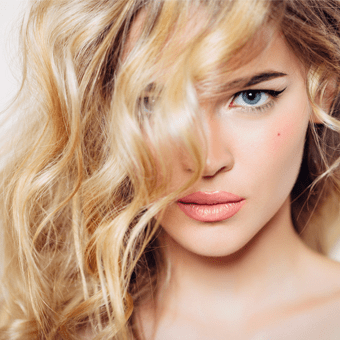
How can I treat heat damage?
Lower the temperature
When blow-drying and heat styling your hair, chances are you’ve put them on high settings to get ready as quickly as possible. If you notice your hair getting dry afterwards, it’s time to think about changing your routine. To combat the damaging effects, consider investing in a hairdryer and straighteners with variable temperature settings. This means you can tailor the settings to suit your hair type, the general rule being low temperatures for fine hair and higher temperatures for thick hair.
Have cool showers
First things first. We’re not saying go cold turkey on your warm relaxing baths to combat your heat damage. However, hot water will leave your hair more vulnerable to breakage and splitting. So when you wash your hair, try to use lukewarm to cool temperatures.
Add thermal protection
The temptation is to skip this step, but it’s important to consider the consequences if you haven’t applied any protection before styling your hair. For this reason, a heat protection spray or oil is a must-have before your blow-dry or heat styling. Not only will they give your hair a smooth finish, but they’ll also preserve the oils necessary to keep your locks healthy and shining.
Our top recommendations for treating heat damaged hair
Here are our top products for heat damaged hair. Find out more on how to look after heat damaged hair.
In a few small drops, the vegan friendly Olaplex No.7 Bonding Oil will give your hair a boost of shine with a silky smooth finish. Reducing frizz, flyaways and tangles in all hair types, what makes this golden bottle truly stand out is it protects against heat up to an incredible 232⁰C. A must for minimising damage and preserving your hair’s health. Also offering UV and colour protection, the Olaplex No.7 Bonding Oil is an essential part of your daily care routine.
If you’re a fan of sunbathing then you’ll need a treatment that restores your hair. This is what you’ll find with the Kemon Liding Bahia Hair & Body After-Sun Shampoo. Enriched with antioxidant sunflower seed extract and conditioning agents, this gentle shampoo is perfect for quenching your hair’s thirst and avoiding the drying consequences of the sun. The results? Shiny and vibrant hair free of static and heat damage.
From Paul Mitchell, the Express Style Hot Off The Press Thermal Protection Spray acts as a heat barrier for the most fragile of hair. Thanks to its blend of rice hull extract and wheat proteins, you’ll be able to fight frizz while building a lightweight protection against your hair and styling tools. The results? Strong and healthy hair with flexible hold.
How do I treat my split ends?
What causes split ends?
We understand finding those frayed split ends can be frustrating, but it’s unfortunately something everyone will face at some point. This will lead to the inevitable question: How do they happen? Split ends are usually caused by excessive stress to the follicles. This includes colouring, heat styling, chemical treatments and harsh brushing. Other causes you may not be aware of include extreme weather conditions and UV radiation.
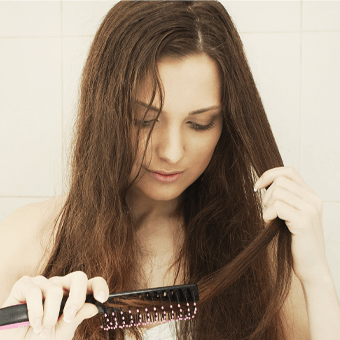
Our tips for concealing split ends
Trim Trim Trim
Split ends often start appearing when your hair grows out. If you want to get rid of them for good, make sure you get your hair trimmed regularly, ideally every six to eight weeks. Why? If you leave your hair to grow out, the fibres will split further and be prone to breakage and damage. If you can’t visit your salon as often, we sell professional quality hairdressing scissors and thinners from brands including Glamtech, all perfect for beginners and which promise utmost accuracy.
Use a wide-toothed comb on wet hair
We understand that after your shower you can often grab the first brush you can find to run through your hair. While a quick fix, it’s time to consider changing your brushing routine if you start noticing annoying split ends. The solution? Use a wide-toothed comb. When brushing, be sure to start from the bottom and comb downwards to ease the knots out. Work your way up towards the roots and avoid any tugging or pulling.
Be gentle when towel drying
After stepping out of the shower it can be tempting to use the “rough towel dry” method and move straight to the blow-drying. However, this can cause more harm than good. Why? Wet hair is vulnerable to knots and breakage, which leads to those nasty split ends you’ll notice afterwards. When you towel dry your hair it’s all about being gentle. Instead of drying a ball of knots on top of your head, pull your hair to the side and lightly squeeze downwards first to remove excess moisture.
Give your hair a break
We understand the desire for ponytails that reach Ariana Grande levels of volume, but wearing these tight hairstyles all the time can pull on your strands and lead to breakage. So let your hair hang loose every so often and allow it time to recover from all of that tension. If you still want to style your hair up, try looser styles using softer hair ties.
Our top recommendations for treating split ends
Here are our top products for treating split ends. Find out more on how to conceal split ends.
One of the best ways to treat split ends is by using professional shampoos that feature gentle ingredients. This is what you get with the Olaplex No.4 Bond Maintenance Shampoo. 100% vegan and paraben free, it’s formulated with patented technology capable of relinking the broken bonds in your hair. Whether that is caused by heat, chemical or colour damage, the No.4 Bond Maintenance Shampoo will strengthen your hair from within when paired weekly with the Olaplex No.5 Bond Maintenance Conditioner.
If your hair is prone to split ends, the Redken Extreme Length Sealer will be the perfect addition to your hair care routine. Formulated with Redken’s Length Care Complex and biotin, this leave-in treatment strengthens damaged hair from within and so allows it to grow longer with increased manageability and shine. When used on its own, the Extreme Length Sealer will reduce the appearance of split ends by an amazing 78%. When used with the rest of the award-winning Extreme range you’ll be able to reduce breakage and split ends by an incredible 81%.
Specially formulated to target breakage and split ends, the L’Oréal Professionnel Série Expert Inforcer Masque will repair and protect the most damaged of strands. How? With its enriched blend of biotin and Vitamin B6. Perfect for all hair types and textures, your hair will instantly become strong, healthy and soft, and results are increased when used alongside the rest of the Série Expert Inforcer range.
